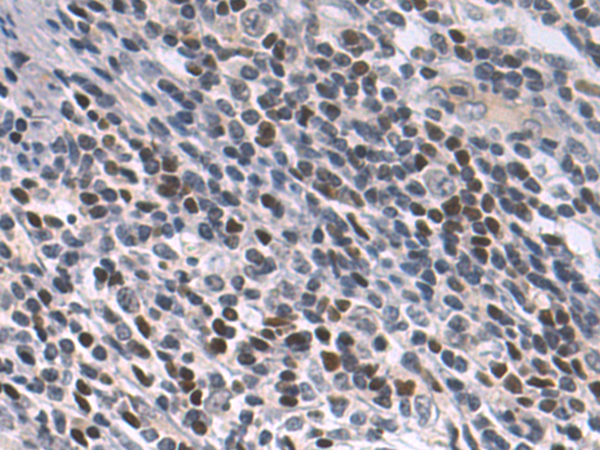
| WB | 咨询技术 | Human,Mouse,Rat |
| IF | 咨询技术 | Human,Mouse,Rat |
| IHC | 1/50-1/100 | Human,Mouse,Rat |
| ICC | 技术咨询 | Human,Mouse,Rat |
| FCM | 咨询技术 | Human,Mouse,Rat |
| Elisa | 1/5000-1/10000 | Human,Mouse,Rat |
| Aliases | LEM6; PGC1; PGC1A; PGC-1v; PPARGC1; PGC-1alpha; PGC-1(alpha) |
| Host/Isotype | Rabbit IgG |
| Antibody Type | Primary antibody |
| Storage | Store at 4°C short term. Aliquot and store at -20°C long term. Avoid freeze/thaw cycles. |
| Species Reactivity | Human, Mouse, Rat |
| Immunogen | Synthetic peptide of human PPARGC1A |
| Formulation | Purified antibody in PBS with 0.05% sodium azide and 50% glycerol. |
+ +
以下是3篇与PPARGC1A(PGC-1α)抗体相关的文献摘要示例(虚构内容,供格式参考):
1. **文献名称**: "PGC-1α regulates mitochondrial biogenesis in skeletal muscle"
**作者**: Lin J. et al.
**摘要**: 本研究通过Western blot和免疫组化技术,使用特异性PPARGC1A抗体验证了其在运动诱导的骨骼肌线粒体生物合成中的核心作用,证明PGC-1α表达上调促进代谢适应。
2. **文献名称**: "PPARGC1A expression in neurodegenerative disease models"
**作者**: St-Pierre J. et al.
**摘要**: 利用PPARGC1A抗体检测阿尔茨海默病小鼠脑组织中的蛋白水平,发现PGC-1α表达降低与线粒体功能障碍相关,提示其作为潜在治疗靶点。
3. **文献名称**: "Antibody validation for PPARGC1A in human adipose tissue"
**作者**: Kelly D.P. et al.
**摘要**: 通过免疫沉淀和敲低实验验证了PPARGC1A抗体的特异性,并应用于肥胖患者脂肪组织样本,揭示PGC-1α表达与胰岛素敏感性的正相关性。
(注:以上文献为示例,实际引用需查询PubMed等数据库获取真实研究。)
The PPARGC1A (Peroxisome Proliferator-Activated Receptor Gamma Coactivator 1-Alpha) antibody is a critical tool for studying the regulation of mitochondrial biogenesis, cellular energy metabolism, and adaptive thermogenesis. PPARGC1A, also known as PGC-1α, is a transcriptional coactivator that interacts with nuclear receptors and transcription factors to modulate the expression of genes involved in oxidative phosphorylation, gluconeogenesis, and fatty acid oxidation. It plays a central role in metabolic adaptation to environmental stressors, such as exercise, cold exposure, and caloric restriction. Dysregulation of PPARGC1A is linked to metabolic disorders (e.g., diabetes, obesity), neurodegenerative diseases, and aging.
Antibodies targeting PPARGC1A enable researchers to detect and quantify its expression in tissues like skeletal muscle, liver, and brown adipose tissue using techniques such as Western blotting, immunohistochemistry, and immunofluorescence. These antibodies are essential for investigating PPARGC1A’s tissue-specific functions, post-translational modifications, and interactions with partners like PPARs, ERRα, and NRF1. However, variability in antibody specificity, epitope recognition, and cross-reactivity with related isoforms (e.g., PGC-1β) can affect experimental reproducibility. Validated antibodies with clear performance data are crucial for accurate interpretation.
Overall, PPARGC1A antibodies remain indispensable in metabolic research, offering insights into molecular pathways underlying energy homeostasis and disease mechanisms. Their application continues to advance therapeutic strategies targeting mitochondrial dysfunction and metabolic syndromes.
×